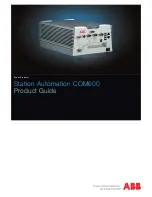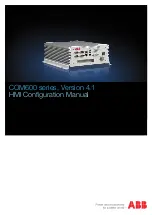
User's Manual
396
Document #: LTRT-89729
Mediant 3000
Notes:
•
If required, you can exclude the "resource-priority” tag from the SIP
Require header in INVITE messages for Tel-to-IP calls when MLPP
priority call handling is used. This is configured using the RPRequired
parameter.
•
For a complete list of the MLPP parameters, see 'MLPP and Emergency
Call Parameters' on page
26.6.1 MLPP Preemption Events in SIP Reason Header
The device sends the SIP Reason header (as defined in RFC 4411) to indicate the reason
and type of a preemption event. The device sends a SIP BYE or CANCEL request, or SIP
480, 486, 488 response (as appropriate) with a Reason header whose Reason-params can
includes one of the following preemption cause classes:
Reason: preemption ;cause=1 ;text=”UA Preemption”
Reason: preemption ;cause=2 ;text=”Reserved Resources Preempted”
Reason: preemption ;cause=3 ;text=”Generic Preemption”
Reason: preemption ;cause=4 ;text=”Non-IP Preemption”
This Reason cause code indicates that the session preemption has occurred in a non-
IP portion of the infrastructure. The device sends this code in the following scenarios:
•
The device performs a network preemption of a busy call (when a high priority
call is received), the device sends a SIP BYE or CANCEL request with this
Reason cause code.
•
The device performs a preemption of a B-channel for a Tel-to-IP outbound call
request from the softswitch for which it has not received an answer response
(e.g., Connect), and the following sequence of events occurs:
a.
The device sends a Q.931 DISCONNECT over the ISDN MLPP PRI to the
partner switch to preempt the remote end instrument.
b.
The device sends a 488 (Not Acceptable Here) response with this Reason
cause code.
Reason: preemption; cause=5; text=”Network Preemption”
This Reason cause code indicates preempted events in the network. Within the
Defense Switched Network (DSN) network, the following SIP request messages and
response codes for specific call scenarios have been identified for signaling this
preemption cause:
•
SIP:BYE - If an active call is being preempted by another call
•
CANCEL - If an outgoing call is being preempted by another call
•
480 (Temporarily Unavailable), 486 (User Busy), 488 (Not Acceptable Here) -
Due to incoming calls being preempted by another call.
The device receives SIP requests with preemption reason cause=5 in the following
cases:
•
The softswitch performs a network preemption of an active call - the following
sequence of events occurs:
a.
The softswitch sends the device a SIP BYE request with this Reason cause
code.
b.
The device initiates the release procedures for the B-channel associated
with the call request and maps the preemption cause to PRI Cause = #8
‘Preemption’. This value indicates that the call is being preempted. For PRI,
it also indicates that the B-channel is not reserved for reuse.
c.
The device sends a SIP 200 OK in response to the received BYE, before the
SIP end instrument can proceed with the higher precedence call.
Summary of Contents for Mediant 3000
Page 2: ......
Page 26: ...User s Manual 26 Document LTRT 89729 Mediant 3000 Reader s Note...
Page 27: ...Part I Getting Started with Initial Connectivity...
Page 28: ......
Page 40: ...User s Manual 40 Document LTRT 89729 Mediant 3000 Reader s Notes...
Page 41: ...Part II Management Tools...
Page 42: ......
Page 44: ...User s Manual 44 Document LTRT 89729 Mediant 3000 Reader s Notes...
Page 80: ...User s Manual 80 Document LTRT 89729 Mediant 3000 Reader s Notes...
Page 98: ...User s Manual 98 Document LTRT 89729 Mediant 3000 Reader s Notes...
Page 103: ...Part III General System Settings...
Page 104: ......
Page 113: ...Part IV General VoIP Configuration...
Page 114: ......
Page 144: ...User s Manual 144 Document LTRT 89729 Mediant 3000 Reader s Notes...
Page 164: ...User s Manual 164 Document LTRT 89729 Mediant 3000 Reader s Notes...
Page 222: ...User s Manual 222 Document LTRT 89729 Mediant 3000 Reader s Notes...
Page 224: ...User s Manual 224 Document LTRT 89729 Mediant 3000 Reader s Notes...
Page 275: ...Part V Gateway and IP to IP Application...
Page 276: ......
Page 278: ...User s Manual 278 Document LTRT 89729 Mediant 3000 Reader s Notes...
Page 399: ...Part VI Session Border Controller Application...
Page 400: ......
Page 402: ...User s Manual 402 Document LTRT 89729 Mediant 3000 Reader s Notes...
Page 464: ...User s Manual 464 Document LTRT 89729 Mediant 3000 Reader s Notes...
Page 465: ...Part VII Stand Alone Survivability Application...
Page 466: ......
Page 474: ...User s Manual 474 Document LTRT 89729 Mediant 3000 Reader s Notes...
Page 494: ...User s Manual 494 Document LTRT 89729 Mediant 3000 Reader s Notes...
Page 497: ...Part VIII IP Media Capabilities...
Page 498: ......
Page 501: ...Part IX High Availability System...
Page 502: ......
Page 515: ...Part X Maintenance...
Page 516: ......
Page 522: ...User s Manual 522 Document LTRT 89729 Mediant 3000 Reader s Notes...
Page 524: ...User s Manual 524 Document LTRT 89729 Mediant 3000 Reader s Notes...
Page 552: ...User s Manual 552 Document LTRT 89729 Mediant 3000 Reader s Notes...
Page 562: ...User s Manual 562 Document LTRT 89729 Mediant 3000 Reader s Notes...
Page 565: ...Part XI Status Performance Monitoring and Reporting...
Page 566: ......
Page 578: ...User s Manual 578 Document LTRT 89729 Mediant 3000 Reader s Notes...
Page 609: ...Part XII Diagnostics...
Page 610: ......
Page 624: ...User s Manual 624 Document LTRT 89729 Mediant 3000 Reader s Notes...
Page 626: ...User s Manual 626 Document LTRT 89729 Mediant 3000 Reader s Notes...
Page 638: ...User s Manual 638 Document LTRT 89729 Mediant 3000 Reader s Notes...
Page 639: ...Part XIII Appendix...
Page 640: ......
Page 864: ...User s Manual 864 Document LTRT 89729 Mediant 3000 Reader s Notes...
Page 871: ...Version 6 6 871 Mediant 3000 User s Manual 55 Selected Technical Specifications Reader s Notes...
















































